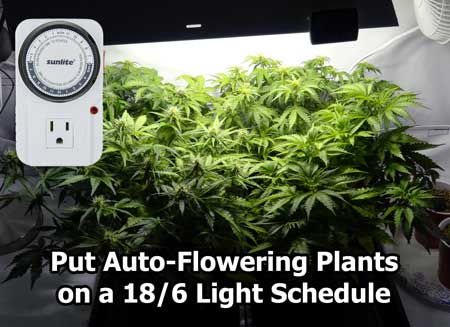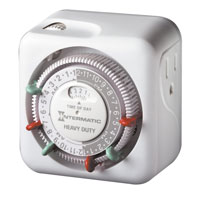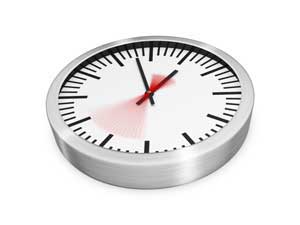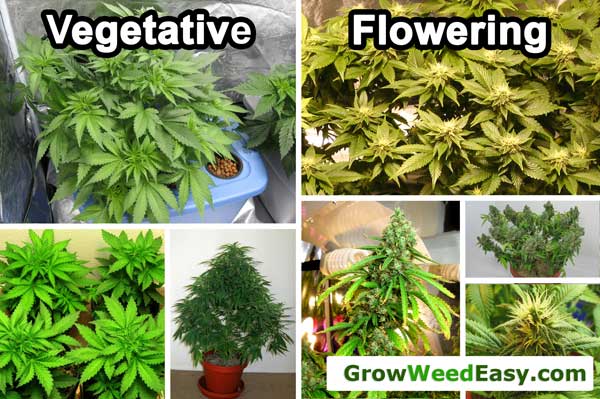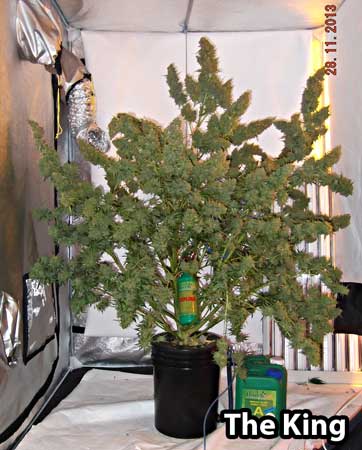by Nebula Haze
How Much Light to Give Autos Each Day
Unlike photoperiod plants where you have to provide special light schedules to get the plant to start making buds, auto-flowering marijuana strains automatically start making buds and are ready to harvest in about 3 months from seed, regardless of what light schedule received.
The next question, then, is what’s the best light schedule to give auto-flowering marijuana plants each day if you are growing indoors?
Short Answer: 18/6 Schedule
18 Hours Light, 6 Hours Dark (perfect for beginners)
Most growers seem to agree that the optimum amount of light to give auto-flowering strains of marijuana is somewhere between 18-24 hours of light a day. When I’ve grown auto-flower plants, I gave them 18 hours of light a day, and 6 hours dark, at least partially because it allowed me to turn the grow lights off during the 6 hottest hours of the day (I live in Southern California where it’s hot most of the year!).
Recommended: 18-24 hours of a light a day
I’ve also seen many great growers give their autos 20, 22 or even 24 hours of light a day.
Do Autoflowering Plants Need a Dark Period?
There are growers who believe auto-flowering plants need a dark period and won’t be as healthy if they get 24 hours of light a day.
I personally haven’t seen evidence of that, and at least in my experience autoflowering cannabis plants seem to do great getting 24 hours of a light a day.
Additionally, the wild ancestor of auto-flowering plants (“Ruderalis” hemp) grows in the northern parts of Russia and may naturally experience nearly 24 hours of light a day in the summer. So it’s not crazy to think that auto-flowering strains will also do well on 24 hours light/day.
However, giving a plant fewer hours of light a day will save you on electricity, and if it does help the plant grow better then that’s a bonus! Combined with the fact that it gets hot here during the day and we have extremely expensive electricity, I always put my autos on 18/6.
I’m very happy with how my plants grow on an 18/6 schedule, but it’s definitely not necessarily the best light schedule to grow autos depending on your situation. Here are a few more pros and cons to consider:
18/6 Pros
- For hot climates, the ability to turn off lights during 6 hottest hours of the day
- Uses 25% less electricity than 24 hours of light a day (which adds up if you have expensive electricity)
- Plants are harder to stress and recover faster from problems. Often the grow light can be kept closer. This extra hardiness can make things a little easier for you if you run into problems, or if it’s your first grow.
24/0 Pros
- Cannabis plants typically grow faster when they get 24 hours light/day, especially during the first month of life.
- A good choice if it gets cold and you don’t want lights to turn off! Keeping the lights on 24 hours a day can prevent the grow space from getting as cold at night
- If plants are very healthy and growing fast, it doesn’t matter if they’re more resistant to problems
Can I grow auto-flowering plants on a 12/12 schedule?
There are situations where it may be easier to grow your auto-flowering plant on a 12/12 schedule. For example, if you’re growing flowering photoperiod plants, you need to keep them on a 12/12 schedule to keep budding. Is it okay to stick an auto in there too?
Yes, but…
Yes, it’s okay and your auto will grow just fine on a 12/12 schedule… except for one thing. Because your auto is getting less light each day, it isn’t able to make as much energy to power growth and you’ll end up with a smaller plant and reduced yields compared to if you’d given more light a day.
One of the really great things about autos is how they’re able to give you pretty impressive yields in such a short amount of time. Part of the way they accomplish this is you’re able to give the plant 18 hours of light a day to power buds, so buds get 50% more light and grow faster than they would under 12/12. By giving your autos 12/12 you’re not using them to their full advantage. That being said, if you don’t mind reduced yields they’ll grow just fine! And it can be fun to stick an extra plant in the tent and let it do its thing!
Auto-Flowering Vegetative & Flowering Stage
When it comes to choosing the best light schedule for growing auto-flowering marijuana strains, it’s a good idea to understand what light schedules are, and how different light schedules affect the way a cannabis plant grows.
All cannabis strains, whether they’re photoperiod or auto-flowering, have two main stages of life: the vegetative (first) stage, and the flowering (second) stage. Think of them as the “children” and “adult” stages of marijuana growth. During the vegetative stage, a cannabis plant grows only leaves and stems. In the flowering stage, the plant stops growing leaves and stems and starts growing buds/flowers.
Most strains of marijuana (photoperiod strains) rely on the amount of light, or their light schedule, to determine when to start making buds. Generally, if a marijuana plant receives 14 hours of light a day or more, it will stay in the vegetative stage (it will focus more on growing leaves and stems without any buds).
Auto-flowering strains don’t rely on light schedules to determine when to flower. Auto-flowering strains will automatically leave the vegetative stage and start budding after about 2-3 weeks regardless of the light schedule they’re given.
“Auto-Flowering” strains of cannabis have different light requirements than photoperiod strains
Auto-flowering varieties of marijuana don’t rely on a change in light schedule to determine when to flower. These strains (sometimes called “Lowryders” or by their species name “Ruderalis”) will finish their whole life cycle in two to three months, regardless of how much light they receive a day. See a grow journal featuring auto-flowering strains.
Light Color Spectrum
Another consideration when growing auto-flowering plants is what light spectrum to use.
What do I need to know about how light spectrum affects cannabis growth?
Normally with photoperiod plants, you would optimally use more blue lights for the vegetative period and more red lights for your plant during the flowering period. With auto-flowering strains, you can follow the same principle by using the blue lights before the plant has shown signs of its gender, and then switch to more red lights once you see the first signs of gender.
Blue Light for Vegetative – bluish light (like from Metal Halide bulbs or 6500k (blue) fluorescents/CFLs) is a great choice for the vegetative stage, which for auto-flowers is just the first few weeks of life
Yellow Light for Flowering – yellow/orange/red light (like from HPS bulbs or “soft white” colored CFLs/fluorescents) tend to produce the best growth and densest buds in the flowering stage. Their color mimics the reddish light from the autumn sun. It is completely okay to give your plant yellow light for its whole life. In fact, that’s what I prefer to do as yellowish light encourages stretchy growth, and I want an auto-flowering plant that grows fast!
Remember: Spectrum is much less important to yields than the total wattage of your lights! (More Light = More Yields)

However, marijuana plants are weeds, and will usually grow at least okay under either spectrum of light during either stage.
Light in any color spectrum will produce good growth and bud as long as you’re using cannabis grow lights and there’s enough brightness.
In fact, many growers use Metal Halide or other more “blue” colored lights for the entire life of the plant and still produce good results. Some growers even prefer these lights for budding.
But the best yields and density in flowering is usually achieved with reddish-yellow light. For the hobbyist grower who may be low on cash and can’t change up the lights, you may want to consider getting all flowering bulbs for autos since they spend practically their whole life in the flowering stage.
Learn more about auto-flowering strains
Jump to…
5 Barriers to Total LED Grow Light Domination!
7 Tips to Growing Top-Shelf Marijuana

